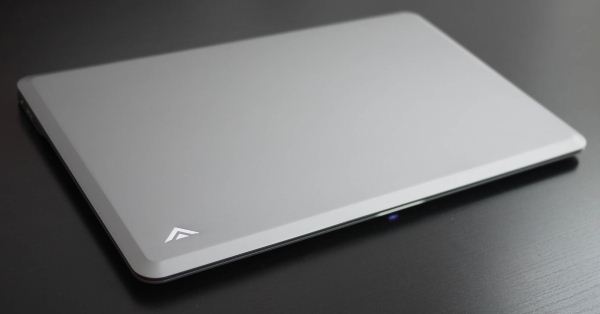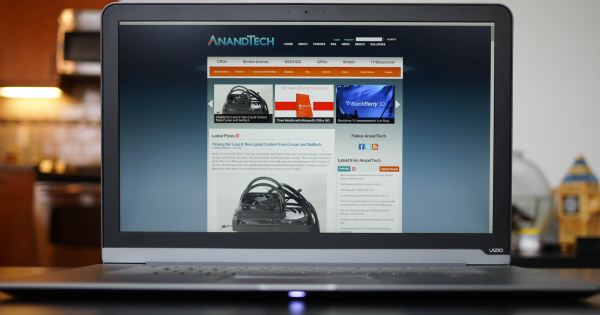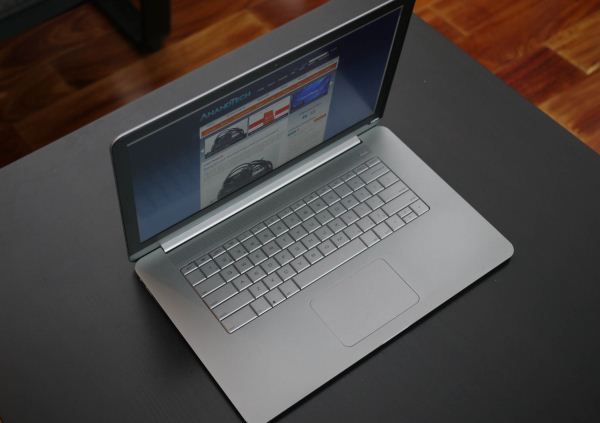Vizio Thin+Light CT15: Something New and Edgy
by Vivek Gowri on February 14, 2013 9:00 AM EST- Posted in
- Laptops
- Intel
- IPS
- Ivy Bridge
- Vizio
- Ultraportable
- Ultrabook
The Vizio is clean and sleek, really a notebook that looks like it was designed by actual industrial designers. This should be a pretty foregone conclusion, but there’s a large number of notebooks out there that don’t look like designers had any say in the designs, especially at the lower end.
The aesthetic is crisp and the entire notebook is very unadorned. There’s nothing glossy on this notebook—not the display, bezel, nor any of the aluminum or the soft touch plastic pieces that make up the chassis. It’s fantastic and I love it.
The body is a single piece of anodized aluminum with a gunmetal finish and the bottom half of the casing is soft-touch plastic. The lid is almost entirely clean, with a small Vizio logo in the top left corner. In profile, the notebook is mostly flat, with tapers at the front and side edges to enhance the perception of thinness. It’s a neat design trick, but I feel like it’s starting to be overused in the world of thin (and not so thin) notebooks. The sides have small portions that are flat, in order to house the meager assortment of ports. The flat part continues across the back of the notebook where the hinge is.
The bezel around the display is perfect—dark plastic with a matte finish, relatively thin, webcam and mics centered above the display, thin aluminum band at the bottom, and a very small Vizio logo at the bottom left corner. Whoever designed it could teach a course on notebook interior design that a lot of other notebook manufacturers could really benefit from.
I’m a fan of where Vizio has gone with their industrial design language, though there’s some refinement that remains on the build quality side of things—the anodization is noticeably coarser than what you find on recent Apple or ASUS devices, while the edges are sharper and more abrupt than they should be. I’ve seen variable build quality between units, with greater degrees of variance in the panel gaps and fit of the keyboard and touchpad. They’re glitches for sure, all signs that point to Vizio being very new to the PC hardware game still, but these are all relatively minor details that they should pick up on and fix as they move forward
Being only 0.68” thick and weighing less than 4 pounds, the CT15 is still slightly bulkier than the smaller and more svelte S9 15” (0.58”, 3.63lbs). Something about the ultrathin 15” form factor, like the Vizio and Samsung, as well as things like the Retina MacBook Pro 15” and the ASUS Zenbook U500, is very aesthetically appealing even though they lack the out-and-out portability of machines with smaller footprints. Even with the superlight weights in play here, the increased size makes this class of system more difficult to use in cramped spaces (such as a plane or lecture hall desk). But damn if they don’t look fantastic.
There’s one huge flaw in this entire design that I’ve been rhapsodizing about though. Surprisingly, it’s not the touchpad—the Sentelic pad that plagued the first run of Windows 7-based Vizio systems has been chucked in favor of a Synaptics unit that’s an absolute breath of fresh air in comparison. Nobody was lying to you, the Sentelic pad actually made the CT15 downright unusable, especially in comparison with the increasingly stellar Elan and Synaptics pads. Sure, they aren’t Apple, but they’re close. The Sentelic was closer to the dark ages for PC touchpads and the series of misguided buttonless pads used by HP and Dell. (Interestingly, my last experience with Sentelic was with the Dell Inspiron 11z from the CULV days. It had a similarly awful touchpad.) But that’s history, and thankfully we have Synaptics and their multitouch gesture suite.
No, the real issue here is the keyboard as well as the metal surrounding it. The keyboard was a problem spot before, too, and hasn’t been fixed. It’s one of the few notebooks that I’ve seen in the last four or five years without a chiclet style keyboard. Even the ThinkPad line, that bastion of old-school notebook design, has moved into the modern world, so it was a bit odd to see the older style of keyboard on this. But I have no quarrel with the keyboard style; the flatness seemed to go well with the rest of the industrial design. Unfortunately, there’s way too much flex involved, and not just in the keyboard itself. The interior aluminum flexes heavily as well, which is odd and indicates a very thin chassis material used. The display also exhibits a bit more flex than I would like, though it’s not a day to day issue like the keyboard and interior is. It’s pretty bad, and a major oversight for a company that seemed to be so detail oriented with the rest of the design.
The upcoming Thin+Light looks basically the same as the current one, but goes a long way towards fixing the interior flex. They made the interior aluminum panel a bit thicker, paired with a stiffer keyboard, and made all the build quality related issues go away. The typing experience is significantly better, though I still think they should move to a chiclet keyboard. You do get used to the flex in the current-gen CT15; it’s not a dealbreaker like the touchpad was previously, but it definitely does detract somewhat from the user experience.














55 Comments
View All Comments
althaz - Thursday, February 14, 2013 - link
I'm on my lunch break and my machine is currently using ~5.2Gb of RAM. 8Gb is the realistic minimum for a lot of people.4Gb is ok if you don't want to do any multitasking, but I pretty much always have a couple of browsers, Visual Studio, Photoshop and Notepad++ open, so for me it's the more the merrier (I have 16Gb at home, which is probably overkill).
The 4Gb of RAM is also the only qualm I have about buying a Surface Pro (but I'll probably still pick one up, I'm not likely to have VS and PS open at once there).
VivekGowri - Thursday, February 14, 2013 - link
See, the problem with that though is that there is a more than established precedent for $1200 ultrabooks with 4GB of memory. Everyone from Samsung to ASUS to Microsoft to Apple to (I could continue). So while complaints are more than warranted (I can think of at least two places in which I voiced displeasure about it) you really can't rake them over the coals without indicting the entire industry.Which isn't necessarily unwarranted, but a bit out of place in a product review like this. Especially when I, as someone who uses ultrabooks as primary machines, haven't had a single issue with a 4GB RAM limit or even close. 128GB SSD is far more limiting than 4GB of memory on both my Zenbook Prime as well as my Surface Pro.
The battery life is a direct trade-off for the display. Vizio should have seen it coming and specced a bigger battery, but from an evaluation standpoint you'd be surprised how much you're willing to overlook when a system is clean, responsive, and has a great display. Find me another 15" machine anywhere near the $900 mark that comes anywhere close to the Vizio's areas of core competency. It's a surprisingly rare combination in today's world.
nerd1 - Thursday, February 14, 2013 - link
Apple still sells non-retina macbook pro at $1199 - with 1280*800 TN screen, 4GB ram and 5400rpm mechanical HDD.It is plain absurd to bash this bargain laptop for the ram alone. And I doubt any 'serious' user will use this laptop for their main workhorse either. Get a real desktop with real GPU. (Or a gaming laptop / mobile workstation if you really want to work on go)
Homeles - Thursday, February 14, 2013 - link
"I can't run my weather forecasting simulations on this ultrabook! This ultrabook sucks!"I can't believe how clueless these people are. This thing is not a workstation. It's an ultraportable laptop computer. Sacrifices have to be made in oder to cut down on weight and to shrink the size of the device. That means upgradability goes out the window. That means lower performance.
It'd make just as much sense to complain about why I can't upgrade the GPU to a GTX 690.
themossie - Friday, February 15, 2013 - link
Non-upgradable? These aren't high-performance machines, yes.But the price difference for the company to have 8 gigs of RAM is certainly under $30. If the customer can't fix it later, do it right the first time :-)
seapeople - Sunday, February 17, 2013 - link
Ever consider that maybe the user experience is BETTER on this laptop with 4gb of RAM vs 8gb?Advantages of 4gb RAM:
1. Hibernate and recover from hibernate are faster
2. Less drive space wasted on the hibernation file
3. Better battery life (important for this laptop, no?)
Disadvantages of 4gb RAM:
1. You can't run weather simulations
2. If you multitask heavily with VS, Note++++++++, VM's, 1000+ tabs open, then switching to an application may require a page hit from the SSD (ogh noes, not the SSD, those are so slow nowadays!)
3. You lose nerd cred in the dorms
blueboy11 - Friday, February 15, 2013 - link
Agreed. Hell, my current laptop uses 6GB of RAM, and it's 3 years old...What gives? The panel on this laptop is totally worth the price to pay, along with the standard HDMI, which sadly I don't have on my laptop. I fell in love with the display that my aunt had on her laptop and it was an anemic PENTIUM processor at that. Why did others not follow this route with the display, sure it wasn't IPS, but it sure was a hell of a step up from what others and my display is. I would've took it any day!!!aguilpa1 - Thursday, February 14, 2013 - link
Why is a dual core i7 not just an i5 since it is just a dual core? Is it because it has HT? Hyperthreading has been around along time and seems artificial to me to not make it available on the i5 chips.arthur449 - Thursday, February 14, 2013 - link
Because Intel's marketing department is evil and they're getting back at consumers because we use engineering codenames such as Ivy Bridge and Haswell rather than 3rd Generation Core architecture.VivekGowri - Thursday, February 14, 2013 - link
With ultra-low voltage parts, the distinction between i5 and i7 is that the latter has been binned for higher clock speeds and higher turbo frequencies essentially. Both have hyper-threading (2C/4T); it's the i3 that really gets hosed due to lack of turbo.